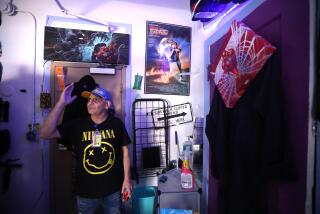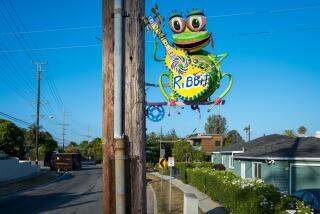The cries of the beholders
SUNDAY night, 7 p.m. Time for the Sugar Shack weekly house meeting. The group gathers on mismatched pieces of furniture in the living room. Dalai, the resident calico cat, drapes herself on the back of an old leather lounge chair.
They tick through the agenda: Is it OK to buy fabric for new curtains? (Yes.) What color is the downstairs bathroom being painted? (White.) Oh, and the sofa in the garden -- it’s got to go.
“We’ve gotten comments from the neighbors,” says Susan Brooks, a 39-year-old movie studio secretary.
David Augusta, who juggles jobs as an actor, masseur and property manager, looks surprised. “Can’t we keep a couch in our frontyard?”
No, the group decides. Haul it away as soon as possible.
The dryer hums softly in the laundry room.
Dena Plotkin looks up, imploringly, at her housemates. “If people could work through their chores.... The house is getting a little bit dirtier than normal,” says Plotkin, a marriage and family therapist.
Sarah Peters, an actress who is 28, agrees. “Somebody’s been leaving scuzz in the bathtub,” she says. “I’m not cleaning someone else’s scuzz.”
In the nearby kitchen, a bare lightbulb juts down from the ceiling in the center of a painted sun with yellow tentacles stretching into a tableau of blue sky and clouds. As always, the light is on. No one has ever found a switch that controls it.
“It’s like the eternal flame of Sugar Shack,” Elizabeth Marley, a 29-year-old architectural student, muses.
In the days of Iron Butterfly and hippies in Haight-Ashbury, Sugar Shack, as its residents have dubbed the house, would have been called a commune. But in the 21st century, this rambling house, perched on the corner of Pico and Windsor boulevards in Los Angeles’ Mid-City area, is called an “intentional community” -- one of at least 700 around the world, according to a U.S. organization that tracks and publishes a directory of them.
The notion of communal liv-ing can stir up images of men and women getting high and having sex, or brainwashed acolytes drinking Kool-Aid brewed by a maniacal cult leader. But neither scenario applies here.
The seven women and two men who -- along with Plotkin’s two children -- make this 7,000-square-foot house their home go to work or graduate school. They share a chore list, have a household bank debit card and shop at Costco for staples. Smoking is not allowed inside, and attendance at the Sunday meeting is expected.
The only residents who presumably are having sex with each other are Evonne and Brent. And they’re married.
“It’s a very tame household,” Marley says.
Still, Sugar Shack is an oddity in this neighborhood, a home caught literally and figuratively between Pico -- with its fast-food joints and auto parts shops -- and Victoria Park, a jewel-like hamlet a block south that is dotted with stately Craftsman houses.
The homeowners of Victoria Park, which is diverse but mostly black, have a courtly sense of what a neighborhood should be, and it doesn’t include a house that is painted blue and has a front door that looks like a piece of psychedelic art from a ‘70s head shop. The neighbors regard Sugar Shack -- originally christened “Princess Suga-duga-wuga-doo” by Plotkin’s daughter when she was 2 -- with some suspicion, unsure what the residents are up to and scornful of the house’s exterior decor.
The house residents -- at the moment, all white -- yearn to be part of the neighborhood. They joined local community groups, baked cookies and held an open house.
When neighbors spurned their invitations, they felt wounded.
“We’re not a drug house, we’re not a day care, we’re not a studio -- all the things we’ve been accused of being,” Plotkin says.
They do, however, consider themselves something of an artists’ colony. Behind their house is a 3,000-square-foot warehouse that functions as an art space for residents and hand-picked visitors who paint and sculpt.
And then there is the mural.
Nothing exemplifies the clash between the Victoria Park homeowners and the Sugar Shack residents like the mural on the side of the house facing Pico. It is a pastiche of exuberant figures of different races, including a woman dancing, a man playing a guitar, a boy riding a skateboard.
Last fall, house residents were informed by the L.A. Department of Building and Safety that they should not have painted the mural without a permit, because it was so large and abutted a thoroughfare. They were told they needed a retroactive permit from the city Cultural Affairs Commission.
That’s when neighbors mounted public opposition to the mural, and the housemates realized that they had their work cut out for them. What they really needed was to win their neighbors’ support.
PLOTKIN’S parents made Sugar Shack possible. When their daughter and her then-husband decided to move from San Francisco with a group of 10 friends, one of the friends broached the idea of communal living, and the elder Plotkins signed on. A house would offer a support system for the group, particularly Dena, a new mother.
In 2001, the couple gave their daughter and son-in-law a $410,000 loan to buy the house and make repairs. They asked only that the group make monthly payments on the interest on the loan.
But almost immediately the group began to disintegrate. No one had a job. Some didn’t pay rent. They argued over everything from chores to motion-sensor lights.
“It was like a bad episode of ‘Survivor,’ ” Plotkin recalled.
A year later, most of the friends were gone. New people moved in.
Over the last half-decade, 47 people have lived in the house, but Plotkin, 39, is the only remaining adult member of the original group. Even her husband is gone. Their divorce became final late last year.
Now, new residents are vetted carefully. Prospects must speak to everyone who lives at Sugar Shack. Variations in the telling of a life story will raise red flags. More important, residents want to see if their potential roommates will devote themselves to the house.
“I visited eight times,” said Evonne Heyning, 31, who runs a nonprofit arts group. “There’s a community cleanup day. I came and painted. I came in nice clothes. They said, ‘She ruined her clothes! She can live here!’ ”
Rent is $650 for a single space, $450 a person for a shared space. That includes Internet access, cable and food basics.
There are three bathrooms and two refrigerators -- one for meat eaters, the other for vegetarians. Brownies are a house necessity a week each month, since the menstrual cycles in the house have synchronized.
In addition to assigned mopping, vacuuming and other cleaning chores, there is one thing everyone must do: wash your own dishes. Housemates rarely have time to eat together.
The one constant among the residents is the search for companionship.
Peters, for example, grew up with siblings and exchange students in Wisconsin and Colorado before she moved to Chicago to become an actress. It was a lonely time. When she arrived in Los Angeles, she was “determined to find community right away,” she said, and responded to a posting from Plotkin on craigslist.
When Peters visited Sugar Shack, “somebody was cooking and somebody was working on the warehouse. I thought, ‘I could live here. It’s like a big family.’ ”
With a mother figure of sorts.
“Dena likes to say, ‘No, no, no, I’m not in control,’ ” said Augusta, 39. “But the figurehead of Sugar is Dena. She was here at the beginning of the dream.”
It was Plotkin whom the original group looked to for guidance when things went awry. It was Plotkin whom one of that group once called “maniacally manipulative.”
And it was Plotkin who coached the tightly wound Augusta just before house residents assembled like troops to go to a Mid-City Neighborhood Council meeting at the Wilshire police station to defend their mural.
“They can chew on whatever part of me they want,” Augusta said as the group prepared to leave.
Plotkin grinned and hugged him. “Remember, we are open and cool,” she said.
THE mural in question is 2 years old and not much different from others that pop up around the city. Artist Olga Socolovia conferred with housemates, sketched a mock-up for them and set to work.
“As far as the subject matter” is concerned, Socolovia said, “I just looked at people in the neighborhood. I did put a lot of musicians and artists on the wall, because I wanted to inspire young kids.”
The housemates insist that no one ever complained about the mural. Victoria Park residents contend that they never liked it. Once the residents of Victoria Park gated their side streets, as a crime prevention measure, the mural became a glaring issue, literally. Residents left themselves with only one entrance into their neighborhood -- at Windsor and Pico, where the house and the mural sit.
And many bristled at what they saw.
Longtime Victoria Park resident Mattie Grant declared the dancing figure to be a “hootchie woman.” “I’ve fought through many things, but this is the worst,” she said.
So the housemates ran a gantlet of meetings to plead their case for a permit -- starting at the Cultural Affairs Commission, then going to the Victoria Park Neighborhood Assn. and on to a special meeting of the Mid-City Neighborhood Council.
At that meeting, Augusta said the mural was a defense against tagging. Before the mural went up, he said, “it was a blank wall and it seemed to scream for art. The neighborhood kids decided to answer it.”
Plotkin apologized. “We didn’t go door to door, which was our bad, totally our bad,” she said to stony faces. “We meant no disrespect.”
But the housemates love their mural. “We don’t want to paint it over,” Plotkin said. “That doesn’t represent who we are. We are an artists’ community.”
Some neighbors were unmoved. “I have been painted out of the mural,” said Tim Mozer, his voice filled with indignation. “I’m a white man married to a black woman with biracial children.”
Actually, a couple of the mural’s characters are white, but Plotkin was sympathetic.
“Oh, I’m so sorry,” said Plotkin, whose former husband is black. “You know, I have biracial kids myself.”
But, somehow, as the housemates had feared, the meeting devolved from a discussion of the mural’s merits into a referendum on Sugar Shack.
“How many people live in your house?” one neighbor demanded to know.
“What does that have to do with it?” Plotkin responded.
“Is it a business?” asked another.
“We’re a residence,” Plotkin answered.
In fact, the house sits in a commercially zoned area. But residential living in those zones is legal, even encouraged by the city. And local laws mandating how many unrelated people can live in a house were struck down long ago.
“I think we should be honest,” said Victoria Park resident Ellen Farwell. The issue, she continued, was the house itself. “I love Dena. I met Dena before I saw her place. I was shocked. The place looks awful!”
Heyning calmly said the housemates were working to repaint. “And we’re open to a dialogue.”
But Plotkin was stung. Exhausted and red-eyed, she dug her hands into her pockets and left her seat.
Two days later, the Cultural Affairs Commission met and decided quickly: The house could have a retroactive permit for the mural. But the commissioners urged the neighbors to work together.
“There are generational differences here,” said Commissioner Richard Montoya. “One lady’s beautiful Spanish dancer is another person’s sexy woman.”
The commission suggested that the neighborhood consult with a mediator. “I urge you, as you go into mediation, do not use ‘them’ and ‘they,’ ” Montoya said.
Later, the housemates gathered in the kitchen, giddy over their triumph, congratulating each other. “You’re a great house leader,” one of them chirped to Plotkin.
“I’m not the house leader,” she said quickly.
It is a role she has, more or less, resisted for five years yet never quite escaped. It doesn’t help that the house is listed in her name -- or that she cares deeply about everything that happens there.
As she drove to pick up her children from their school, she mused on whether it was time to disengage in a more profound way.
“It will probably help with the power structure of the house if I’m not there,” she said.
“I think the house thinks it’s more dependent on me than it is.” She pondered whether to move back to the Bay Area.
But the next day, Plotkin returned to the flow of the house. As a peace offering to the neighborhood, a Sugar Shack resident painted over the front door, erasing the bright colors and exorcising the ghosts of previous residents. When she was done, the door was a stark white.
When Plotkin’s daughter, Jones, came home from school and saw the door, she burst into sobs.
Her mother smiled ruefully. “She’ll get over it,” she said.
*



